The Perusal #39: Refree, Phil Ranelin And Wendell Harrison, Hög Sjö, Esbe, Galactapus, Seljuk Rustum, George Winstone…
January 9, 2023
Dominic Valvona’s Monthly Eclectic Tastes
Album Reviews
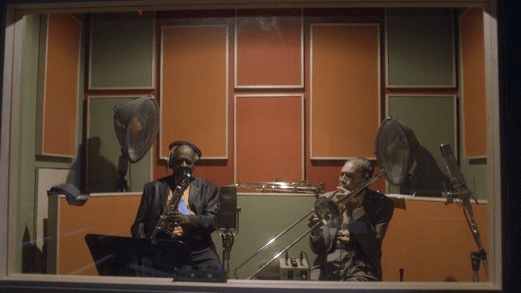
Phil Ranelin And Wendell Harrison ‘JID016’
(Jazz Is Dead) 27th January 2023
Old partners brought back together under the Jazz Is Dead banner, trombonist Phil Ranelin and clarinet/tenor saxophonist Wendell Harrison revive the tribe vibe of their iconic partnership from the 70s. Albeit through a modern lens, revitalized with the production and addition of the label’s instigators Adrian Younge and Ali Shaeed Muhammad.
First conceived back in Detroit after crossing paths earlier in New York, Ranelin and Harrison set up the dedicated Black consciousness imbued Tribe hub (a label, recording ensemble, community project and magazine) in the early 70s. Much of that fertile ground is trodden once more across a recording of live sounding roots music, spirituality, creation story stirrings, Afro-jazz and starry cosmology. Legacies are bound musically and business wise: that Tribe ideal and action plan outright revolutionary for the times as an example of independently owned community enterprise and spirit. And an impressive, enviable CV is channeled: Ranelin a session player on various Motown recordings, side man for Freddie Hubbard in the late 70s and early 80s, going on to record with the hard-bop pianist Freddie Redd in the 90s – not forgetting that surprising appearance on the Red Hot Chilli Peppers self-titled album in the mid 80s – but also as an artist in his own right, and Harrison, with his part in backing Marvin Gaye in the 60s as a member of Charles Campbell’s band, stints in New York with such acolytes as Grant Green, Big Maybelle and Sun Ra, a tour with Hank Crawford and also for his own solo work – most notably the iconic An Evening With The Devil LP.
Less of a weight, both participants on this new batch of recordings (laid down at Linear Lab Studios in Highland Park) freely call upon that heritage yet sound very much in the moment; bursting into life yet also reflective as they open up the valves and blow such sagacious breaths. With Younge and Muhammad playing a number of instruments (from a B3 organ to electric bass) and Greg Paul on drums the long and short woodwind and brass is filled out to the tune of funk, inner city blues, tribal percussion, contemporary breaks and some Latin-American flavours.
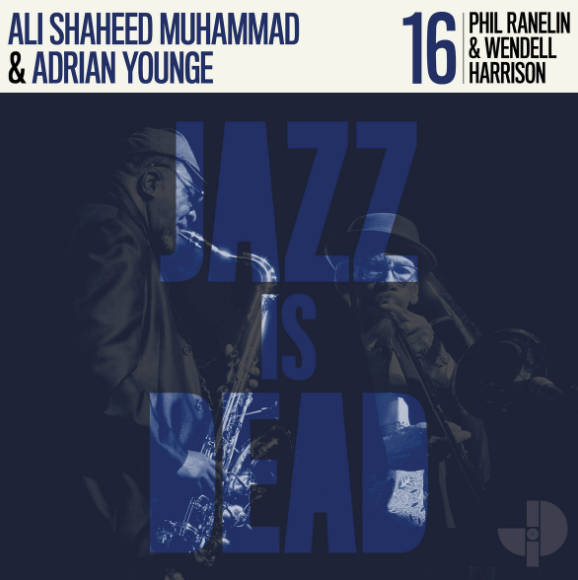
It begins, well…. in the very beginning with ‘Genesis’. A fecund of stirrings, growth as Eden begets the Fertile Crescent. The ancestry is all there on display; the mood an enlightened but fiery one riled by electric bass scrunches and tenor squawks. Shaken serpent percussion rattles in the Biblical waters of a more tuneful 80s Art Ensemble Of Chicago and Marcus Belgrave vibe.
Funk in the presence of esoteric learning, ‘Open Eye’ has a quickened pace. Harrison and Ranelin squeeze the air and perform downward spirals across an African shimmer. To the temple next on ‘Running With The Tribe’ before hotfooting across the grasslands to the soulful, El Michels Affair tinged and dreamy ‘Fire In Detroit’ and the stargazing ‘Ursa Major’: the bulb like reverberating organ notes of which reminding me of sci-fi aura Greg Foat.
This free-spirited partnership proves energised throughout; riffing off the heritage but also in congruous union with their younger foils. Jazz is dead yet reborn with the sound of Black consciousness. Both pioneers of their trades deliver another rich lesson in articulating independence and free thought, whilst evoking the Tribe back catalogue; a look back but in the process of moving ever forward. Class all the way!
Refree ‘El Espacio Entre’
(tak:til/Glitterbeat Records) 20th January 2023
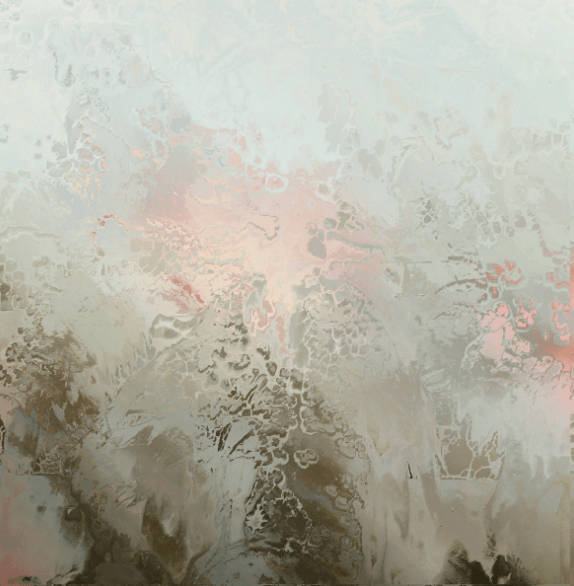
Coming on like an Iberian vision of the Neel Murgai Ensemble and Hackedepicciotto trapped with Nacho Mendez (I’m thinking of the Ángeles y Querubines album) in an undefined, veiled timeline and atmosphere, the follow up sketchbook album of Raul Refree’s imagination is yet again a unique, “seamless”, amalgamation of reflective enquiry, soundtracks, semi-classical etudes and the visceral.
Four years after the noted producer and foil’s first album for Glitterbeat’s instrumental-led imprint tak:til, La Otra Mited, and his successful collaboration with the incredibly-voiced Fado interpreter Lina, El Espacio Entre is both of those musical worlds combined, yet also something different.
In calling it a sketchbook I may have rendered this album a disservice. All fourteen tracks, no matter how short, in vignette forms at times like momentary breaths of emotion or parts of a bigger story, couldn’t be more finished or improved upon. Once more playing with and entwining a Spanish heritage that stretches back to the age of courtly sonnets, medieval period church services and the traditions of pastoral Spain during the time of Goya, through to Franco, Refree creates a very moving portrait of lamentable and dramatic mood pieces. Some of which are so gently played as to be almost ghostly, a reverberation of something more concrete lost through the process of time and history.
Consumed almost by the vapours, it begins with the sorrowful aria-like voiced and darkened atmospheres of the opening lowly-bowed ‘Lamentos De Un Rescate’. There’s a beauty in pain it seems, as Refree sensually balances an ethereal gauze with a growing unease and familiar echoes of the classical with more mysterious electronic, synthesised elements: a vocoder-like wobble on that female vocal line almost gives it a strange modern R&B feel for the shortest of moments.
Refree weaves the concertinaed, bellowed and spindled into a stirring score. The avant-garde runs with lovely mirages of melody, some both carefully and freer guitar parts, the resonance of hidden metal and tin tools, deeper thumps and stamps of bass and brief choral male voices – which could be from anywhere on mainland Europe. A piano’s inner workings can be used like a spidery creep down the side of a frame drum; an innocuous radio in the kitchen can be retuned to pick up a Mediterranean mandolin-like and vibraphone buzzed broadcast into Bowie and Eno’s studio; and a psych-folk fairytale can be created from harmonic-pinged acoustics, cautionary echoes and the mystical. The grand finale, ‘Una Nueva Religión’, seems to layer the reverent with a near-distorted blast of No Age drums and a toy-bellowed breathy piped organ.
Heightened emotional swirls and plaint exist alongside quieter pitched sensibilities and the gossamer. Esoteric Meta goes hand-in-hand with tradition and the classical.
Not so much an album of performances as a quality production of fleeting descriptions, of moments captured in poignant scenery, Refree’s second such album of scores and sound pieces is an incredible, immersive mood board of magical and often plaintive thoughts, feelings, processes and films yet to be made. I’ve been sitting on this album for months and it never loses its initial pull, gut feeling, and yet I can also hear new things on every listen. Raul Refree is a great talent indeed. And this is already high on my list of choice albums form the year.
Hög Sjö ‘S-T’
(Smuggler Music) 27th January 2023

Away from the hit-making machine of popular music as a producer/musician/songwriter with such notable stars as Robyn, Charli XCX, Taylor Swift, Dian Ross and Santigold, Patrick Berger can be found nurturing a magical realm of instrumental reminisces, landscapes and imaginary soundtracks under the Hög Sjö title.
The Swedish dreamer, accompanied by a Scandinavian-sounding sextet of musicians, scores a kind of Peter Doig seeped cloth-canvas tapestry of cultish European composers, library music, the bucolic and perfumed garden psych-folk on a generous self-titled album of fourteen tracks.
Sophisticated with a mostly languid, hazy and gentle nature, touches of soft Polish jazz scores can be detected sharing room with Hampshire & Foat, The Soundcarriers, Mellow Candle, The Apples In Stereo, Bruno Nicolai and Paolo Ferrara. And yet there’s a relaxed air of the El Michels Affair and Broadcast on the swimmingly soulful, fuzztone ‘Overswum’, and both Omer Khorshid and Baba Zula on the souk-rock tremolo desert thrill, ‘Raki’.
Meanwhile, the opener, released in the run-up to the album a few months back, ‘Gnosienne no. 6’, is actually a dreamy magical Air-like vision of Erik Satie’s inventive and self-coined dance-like compositional melodies of the same name – a novel title probably derived from “gnosis” and the gnostic sects the iconic composer was ingratiated with at the time, or, adopted from Greek myth. A nod to the classical, its been given a little more oomph, crowned in modernity and floated into a softly quilted musical world.
Offering little in the way of true originality, with the sound of very familiar melodies and influences, Berger has absorbed a great record collection and through the dewy haze, the sun-dappled rays and lunar bends, cast a mysterious and often reflective mirage of traverses, wanderings, scenes and settings. Some of which is quite beautiful and enchanting.
Seljuk Rustum ‘Cardboard Castles’
(Hive Mind Records) 3rd February 2023
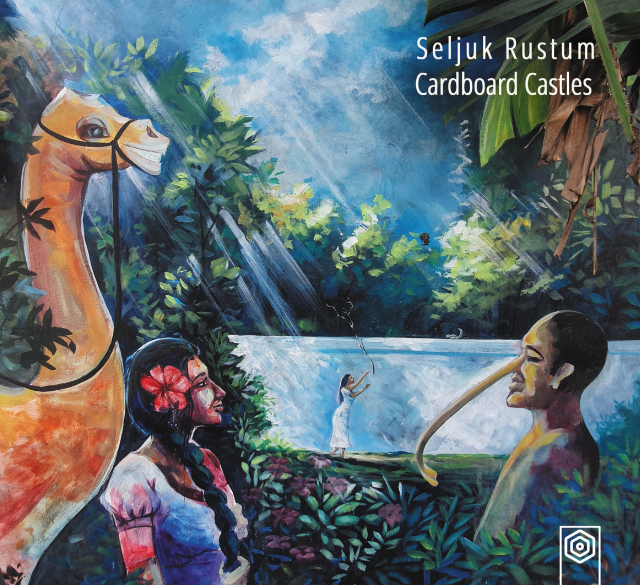
Imbued by a rich history of place and time, and the trading winds that brought so many atavistic and less ancient civilizations to its natural harbor hub, Seljuk Rustum’s Kochi-base of creative activity is a city steeped in polygenesis sounds and ideas.
The major hive of commerce in the coastal southwestern Indian region of Kerala, crowned the “Queen of the Arabian Sea”, Kochi played host to the Greeks, Romans, Jews, pro-Islamic and post Arabs, Portuguese, Dutch and British. And was once allied to the Ming Dynasty during one such golden apex of renown and power. This ebbing and flowing tide of different cultures is, to a degree, channeled on the polymath artist’s first album for the most brilliant and eclectic UK label Hive Mind (a regular feature on the blog since the imprint’s original conception six years ago).
Building up a congruous musical picture of quality worldly classicism, ambient and trance electronics and the exotically dreamy, the all-round creative Rustum (from painting to recording engineer; musician of repute to director of the Forplay Society space) has woven together ten separately improvised peregrinations and performances, made during a five-year period from 2016 to 2021. And for the most part these tracks are collaborative, created with a myriad of local-ish and international travellers, stepping over the threshold of Rustum’s studio.
Although certainly Indian in reference and sound, with brassy resonance, subtle oboe and horns produced mizzle drones and a pattering of rapid and buoyant tablas, the musical mood palette spreads much further afield: to the Mongolian Steppes, the mysticism of the Orient and even out onto cosmic, astral planes.
But it’s the local Cochin String Orchestra that helps with opening this album of movements; furnishing the poetically painted ‘Body Of A Dolphin, Breasts Of A Cloud’ (a strange hybrid) enchantment of the classical, folksy and reversed – it actually reminded me of this month’s bedfellow, see above, Refree in part. Later on there are references to what’s become a rather lazy, sometimes derogatory shorthand term for the Indian (but also Asian-wide) diaspora or immigration abroad, “desi”, and a sample borrowed from the Alan Lomax ethnographic archives of indigenous Malayam speakers on the Daniel Lanois and Emtidi Indian-kosmische stirred ‘Desi Bunny’. For anyone curious, Malayam is a branch of the Dravidan family of languages found across wide swathes of southern India, northeastern Sri Lanka and southwestern Pakistan, and is related to Tamil. It’s also been designated a “classical language of India” no less.
Elsewhere on this suffusion of mirage and hallucinatory perceptions, arppegiator bulbs of light delicately bobble as staccato melodica and sympathetic and wept violin (both played by the multitasking and recurring foil Sekhar Sudhir) evoke the exotic and scenic, the spiritual and mysterious. The mystical valley awakened ‘Fallen Sky’ sounds, in part, like Popol Vuh or Syrinx, whilst the “100 years ago…” sampled wondrous time capsule title-track reminded me of Hive Mind labelmates University Challenged putting out cosmic-trance feelers to Amorphous Androgynous.
Exquisitely layered and softened for the most part, enervating any ideas of unease, there are nonetheless certain veiled passages of uncertainty, even something troubling. The album’s oddest leftfield play, ‘The Happiest Country Has No History’, which features Akshay Ashokan on electric guitar and Sudhir on acoustic, features a voiced delivery of accumulated lyrics and lines. An undercurrent of something disturbing is apparent when the “sweet sixteen”, “so pristine” lines are followed up by some inappropriate touching by “uncle”. To be honest I’m not sure what’s going on with this track, except it does have a disturbing dimension to it. But for the most part the musical mind of Seljuk Rustum and his partners on this magical, entrancing and dreamy journey, reveals a great sonic knowledge, both a part of, yet also in some ways, escaping history. A great start to the year for the Hive Mind, and welcoming addition to their roster; an album I can see making this year’s choice lists.
Galactapus ‘The Rainbow Of Wrong’
13th January 2023
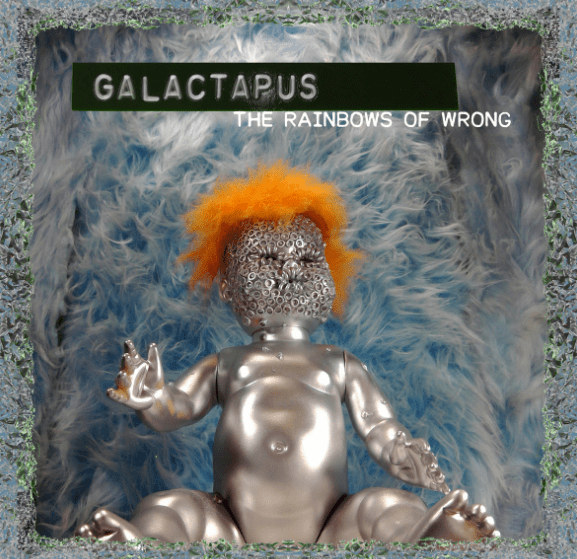
In what could be the year’s boldest bonkers move, and the most playful, Galactapus’ second album is pure mayhem and creeping wildness.
Totally shrouded in mystery, this “faceless” rambunctious five-piece hailing from Minneapolis feast on, and orgasm, to an omnivorous hallucinating rainbow of the occult, psych, prog, Westerns (think more Jodorowsky and Cormac McCarthy than Ford), post-punk, krautrock, kosmische, doom and, well…. a whole lot more of the unexpected.
This eclectic long list of musical points can all happen in the same track too. Take the epic ‘Radio Kolossos’, which retunes the Fortean Times transistor to bursts of toybox Zappa, the chaotic amp whistles and blow-outs and wire-y guitar mania of the Red Crayola, the dramatic prog rock indie swells of Crack Cloud and Babylon Zoo, and a surprising dose of the B-52s. But then, nearly out of nowhere, the action dials up Can’s Monster Movie. It’s a constantly evolving, often rotating, trip in which the course of direction remains anyone’s guess.
They plunge the listener into the esoteric one minute with cult-like GOAT and Itchy-O vibes, incantations and ritualistic invocations of 70s horror soundtracks (‘Your Face Is inside Out And Your Wig Is On Fire’), and into a mushroom induced commune rave-up of Syd Barrett, Ozzy Osbourne, Steve Hillage and the Olivia Tremor Control the next (‘Giftworn’). Later on this both silly and bestial gaggle trample over Joe Meek (as transmogrified by Matmos and Charlie Megira), The Residents, The Electric Eels, Sun City Girls, Cramps, Acid Mothers Temple, The Strokes and Ariel Pink. Strangely, the final ritual, ‘It’s Over When We Say It’s Over’, has room for a brief respite of cosmic transcendence in the style of Ariel Kalma and other such kosmische divine stylers.
There’s so much to unpick, decipher and entangle from this madcap laughs bizarre chemistry. A demonic Sabbath turns into a peyote Spaghetti Western on an album that exists in its very own cosmology and manic obscurity. Untethered magik, over-sexed hormones and fun reign supreme on a fantastic psychedelic work of art.
George Winstone w/ Ben Monder ‘Odysseus’
20th January 2022
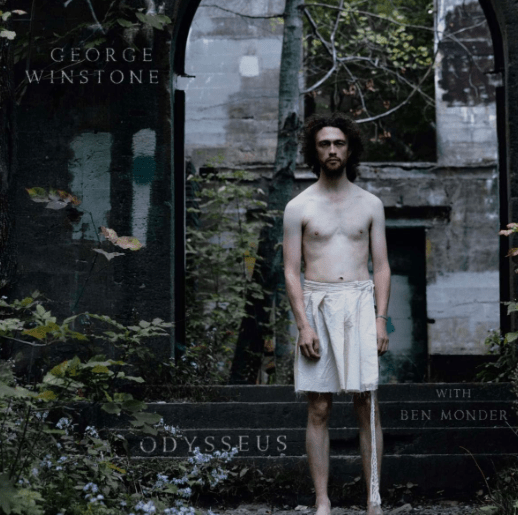
Perhaps too close to the tragic cliché of the struggling jazz musician, George Winstone’s personal life has been riven with strife. Despite the notable rep as a rising star, a role as a leading light in the in-crowd London scene, and an enviable CV, Winstone has had to bounce back from rotten odds to break through as a jazz acolyte.
Dropping out if school, homeless for a time, the saxophonist bandleader was forced to sleep on buses and at Heathrow Airport. A necessity no doubt, the real low point must have been when he had to sell his prized saxophones. But after becoming a father, the stakes were upped and mind concentrated. And it seems the creative spirit lit. A move to the jazz mecca of New York and a nation steeped in jazz lore marked a new chapter.
Now fully integrated into that thriving community, Winstone, bolstered by the encouragement of such luminaries as Chuck Correa and Jacob Collier, has found room to grow. And despite a, if you believe the hyped-up press, burgeoning British jazz scene, it was the allurement of America with all its history and legacy, the freedom, that won out. I imagine it also poses more of a challenge, more competition too. But to make it there is to truly make it.
Rubbing shoulders with an explorative group of players, Winstone found a place amongst such notable company as Aaron Burnett and Jon Elbaz, and later on, with his willing foil on this recording, the guitarist Ben Monder. They actually crossed paths at one of Monder’s gigs in the West Village; Winstone impressed enough to ask for guitar lessons from his future collaborative partner.
Pretty much hitting it off from the outset, the pair accelerated their creative bond with an improvised, unprepared performance at the popular Ornithology spot in Bushwick, Brooklyn. It must have been some show, as the audience encouraged them to make a recording together. And so was “born”, in part, the Odysseus entitled peregrination; a reference to shared travails no doubt, an odyssey in which Winstone’s own search for home mirrors that of the Greek mythical hero immortalized by Homer.
Although there’s no actual reference to that decade-long adventure, that struggle to make it home to Penelope after finally defeating the Trojans by guile, I can’t help but imagine some Hellenic voyage of tumults, setbacks and beauty across the Aegean Sea. You can’t help but pick up on the atmosphere of what is essentially another unprepared adventure, Winstone and Monder responding and sculpting tones, melodies and displays of evocation off of each other’s explorative craft and sense of navigational draw.
Meaning to avoid any demarcation of style, any labels, this performance, split into nine parts, assails jazz, classicism, fusion and even droning doom. Because whilst Winstone’s drifting, wafting fluted and spiraled saxophone melodies and freeform lines channel Coltrane, Coleman and Anthony Braxton (at their most tussled and wildest), Monder’s buzzed and fuzzed electric guitar vapours and bedding drones are more in the mode of Sunn O))) and Boris: even Scott Walker when he picked up a guitar for the Tilt album. It adds a touch of darkness, gristle and a bit of mysterious industrial dissonance to these sonic manifestations, but never quite lurches over into the truly harrowing.
At other times the drama dissipates to reveal the light, as Monder’s playing evokes the dreamy, the rhythmic (when also simultaneously thumbing those bass-y sounding notes) and untethered.
Moments of heavy Meta(l) on an ancient seas turns into fog-lifted spells of avian flight, as both musicians drift towards stirring places, sail through storms and River Styx like mirages.
Winstone and Monder combine forces for a successful soundtrack exploration that both transcends jazz and surprises with unexpected sonic distortions into darker, mysterious climes. A road less travelled you could say.
Beats & Pieces Big Band ‘Good Days’
(Efpi Records) 27th January 2022

A big band jazz swell and swing fused with Radiohead’s progressive cannon of intelligent brooding and mathematics, the Beats & Pieces ensemble bounce, chime and lift horns to a score of untold influences and inspirations. In fact, this latest considered, yet also dramatic album (the troupe’s third studio album proper) reminded me in parts of the highly acclaimed NDR Big Band’s concert with Wayne Shorter, but also Woody Herman, Bill Evans and a rewired Mouse Bonato Sextet.
It goes without saying that you could also add Mingus, Tippett and Coltrane to that mix, and also a whole slew of 90s and noughties sounds too, including the introduction of a laidback Latin-jazz club beat and subtle dance music bass on the smoky, changing vibrato and crooned saxophone featured ‘Cminriff’.
With fourteen musicians in the lineup, all vying for attention and space in this big band sound reimagined, the Good Days (ahead rather than behind us we hope) entitled album begins on a more idyllic note. ‘Wait’ gently conjures up a bird tweeting countryside ambience of filed (literally) recordings and reflective bulb-twinkled notes. This is followed by a proper workout, a lying of the land, mood piece called ‘Op’. Progressive elements merge with the trippy, with clarinet and horns, the classical and subtle electronic undulations. Later on the Radiohead-esque piano cuts through with run after run and spells of loose freeform jazz.
As the title suggests, ‘Elegy’ marks a plaintive change of mood, and feels like some contemplative 60s jazz classic with its cupped trumpet nuzzles, resonating and swanning saxophone, romanticized swirls and emotional pull. But, especially at the start, it evoked in me suggestions of a Floydian haze; sending Coltrane lament out onto very different waters indeed. By contrast, the shorter ‘Db’ seems to echo from a NYC subway platform; suddenly bursting into a heavy tumult of accelerated entangled horns.
‘(blues for) Linu’ is both an illusionary and hallucinogenic off-kilter score of L.A. shoegum, swing and Lalo Schifrin, whilst ‘Woody’ progresses from disjointed big band and jive to Brian Wilson’s ‘Mrs. O’Leary’s Cow’ from the SMiLE album, to a final reverberating sign-off of The Beatles final ‘A Day In The Life’ piano chord. The final track, a reprise of the opening bucolic meditation, finishes things of with serenaded horns and the feel of an old movie score.
It all feels like a complete work, an encapsulation of the moments it was recorded in, the moods and places it is meant to arouse and evoke. With no jostling for room, despite the numbers of those taking part, every instrument is heard, every performance an intrinsic part of the whole. Visceral, intense and yet also calculated, skilfully played, it takes some beating to package such a big sound so it can at one moment burst forth in a rush, and in another, sound somehow intimate and personal. “Good Days” indeed for this big band.
Esbe ‘Blow The Wind Southerly’
(New Cat Music) 27th January 2022
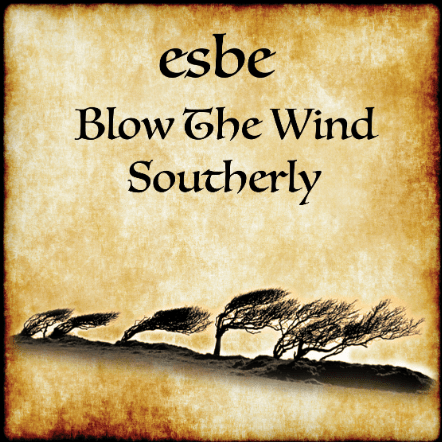
Stripped almost entirely of everything but the siren’s voice, Esbe’s latest songbook fills the space with just the use of effected vocals and a number of scene-setting sounds mostly recorded from nature.
The sometime Daughter Of The Desert and Egyptology imbued artist once more takes a well-worn historical cannon of standards, following up on last year’s Under Cover album. Whilst that collection featured a swelled, but also articulate, accompaniment of strings and synthesized augmentation, Blow The Wind Southerly builds an atmospheric world out of Esbe’s range of vocal utterances, tones and harmonies; layered or looped at times to evoke instruments or a rhythm.
This showcase in vocal manipulation can’t however take away the beauty of Esbe’s voice, which invokes a timeless quality throughout a selection of nursery rhymes, rounds, traditional ballads and folk songs. Reinterpreting works with a providence that remains often lost in the mists of time, there’s a passage linked back all the way to the Medieval epoch on the opening idyllic farmyard chorused cuckoo song, ‘Summer Is Icumen In’. Off to a diaphanous start, Esbe interprets an incipit text from England’s 13th century summer cannon. Esbe being Esbe though manages to also, rather congruously, waft in lyrics from Gershwin’s famous ‘Summertime’ spiritual jazz standard; this sends the English pastoral off into a languid deep southern American direction.
Leaping forward a century or two, from the time of the Tudor court and Henry VIII, the City of London church bells nursery rhyme ‘Oranges And Lemons’ finds the original pulled deftly into the contemporary, merging the sacrosanct with an air of the arty and also uneasy. It’s a strange feeling, with all the original elements, the London sites (modified or interchangeable depending on which version, and for what audience) suddenly more dreamy and alluding lyrically to something slightly ominous: mysterious is a better word perhaps.
It’s been said, by me especially, that Esbe brings a sense of otherworldliness to her music. This is none more so then with her increasingly disturbing take on ‘Three Blind Mice’. A song, admittedly, full of charming animal cruelty, this age-old familiar takes another ‘round’ into the supernatural, or at least alien.
Biblically harrowing, an interpretation of the 18th century English ‘Coventry Carol’ – so called because this is where it was traditionally performed – is rightfully mournful, yet also has a cryptic Gothic-like quality too. Part of The Pageant Of The Shearman And Tailors mystery play, this Nativity set performance takes its cue from Herod’s Massacre Of The Innocents, as laid out in chapter two of Matthew’s Gospels. The part of a mother soothing her soon-to-be murdered child with a final lullaby is lamented in an intimate requiem of Middle Eastern grief, as distant muffled bells signal the impending doom.
Plaints from Northumbria and folksy spells from Scotland share space with the Lomax almanac on an incredibly voiced songbook. The first of those and the album’s title-track sounds like the Cocteau Twins in a venerable state of longing, on a nautical yearn for a returning lover. The latter, ‘Go Tell Aunt Nancy’, has rarely been recorded, but it’s known by many generations as a sort of folksy comforter despite the dead goose in the room theme: “who died in the mill pond from standing on her head”. A lulling “la la” and airy appearance can’t help but turn into an avian eulogy.
Artfully composed with a balance of the esoteric, the traditional and the experimental, Esbe’s latest collection of conceptual reinterpretations showcases an impressive talent. Above all, Esbe breathes new life, a new experience into the familiar without losing each song’s charm, impact or grace.; the atmosphere remaining as timeless as ever.
Flexagon ‘The Towers I: Inaccessible’
(Disco Gecko) 3rd February 2023
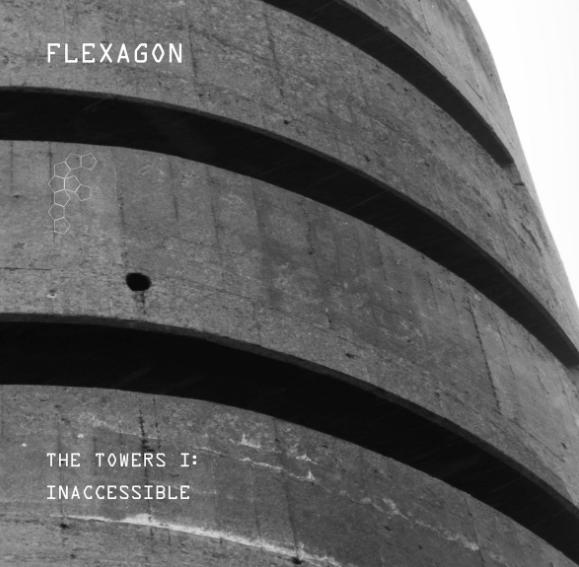
Through a near domination of the high seas, a skill in winning wars, a Norman lineage and generally to annoy the French, the Channel Islands have been a British dependency for centuries. During that time a whole lot of history has passed under the bridge; the last 200 years of which are channeled by the Guernsey native, artist and environmental, site-specific composer Flexagon.
The second largest of those islands, Guernsey lies off the Normandy coast. A vital strategic – in defensive and military terms – outlier that’s been fortified numerous times during various crisis of invasion. Guernsey’s landscape is dotted with both leftover relics and modified remnants from the Napoleonic, Second World War and Cold War eras. Many of which now form the backdrop for the first in a proposed trilogy of such works from Flexagon, who blends field recordings, spoken word, touches of the neoclassical and trance with a three of four decade span of analogue and digital electronica, downtempo ambient music, soundtracks and controlled techno.
In practice this translates into the vaporous stirrings of Vangelis and Jarre on the album’s opening dissipating misty and mysterious dreamy ‘Gazing At The Tower’; the early trance-y techno of Autechre and Seefeel with shades of Banco De Gaia on ‘Le Mont Saint Windmill’; and both the kinetic lattice of 80s Sakamoto, futurism and Cliff Martinez with the more natural trudge across grassy fields ‘Fort Saumarez: MP2’. The last of those being a defensive fort built in 1804, and named after Sir James Saumarez, then commanding the British Royal Navy in the area, was much later commandeered by the occupying German forces during WWII (the only part of the British Isles to be occupied). Two war periods cross over into this piece of psychogeography, the ghosts of the past traced through sonic atmospherics that dwell and yet move on. Of course it may project a whole different feel and environment to someone unfamiliar with the Guernsey landscape of towers, follies and more practical useful infrastructure: such as that already mentioned windmill and a water tower.
Thanks to the Island’s National Trust page I was able to explore and get a sense of these structures. As it happens, the head of that organization on Guernsey’s family is represented on the ‘Ozanne Tower: The Folly’. Built by one of Island’s oldest families (dating back to the reign of Edward III), the Ozanne coat-of-arms is still visible above the doorway of that stout two-floor turreted castle-like jolly. In conveying this piece of history, Flexagon (who tramples across the grass to reach it) introduces us to the dreamy “cor anglais” – a sort of double-reed woodwind instrument, a member of the oboe family – playing of Nerine Ozanne, and a gentle but deeply felt bow of emotion from the cellist John Surcombe. A haze can be felt around this mystical bucolic scene; the sort of thing artists like From Mouse and Alexander Wasylyk do so very well.
Fortifications, called Loophole Towers, built during a year of hostilities with a post revolutionary France in the late 1700s, are given an ominous and haunting soundtrack and a crackly whispered narration – from a script written by Shaun Shackleton. This adds to a sense of past trauma and forbade, especially with a curse from the narrator James Le Page, “dragged” off by the “bloody militia”. I would suggest all is not well with this restless spirit.
More obvious soundtracks of course encapsulate such structures as a communications tower with a constantly moving retuning background fizzle and buzz of various transmissions. A slow introduction of early Warp and Massive Attack electronica keeps this radio display company. And as you might expect, ‘Water Tower’ is, well…. wet. But in a surprising way that uses the interior – or so it sounds – like a slow moistened but warm rhythmic effect.
A work of site-specific atmospheric stirrings and timelessness, The Towers I: Inaccessible album translates the off-limits sites of Guernsey into a multi-layered sonic map for inquiring minds. An Island life, history and shared trauma is transduced across a mix of styles and delivery methods as both repurposed and more derelict out of bounds architecture is allowed to breath and to tell stories of the history that’s passed through its doors. Even with the all too awful reminders of Guernsey’s occupation (finally liberated in the May of 1945 after nearly five years of German authoritarian rule; at least a thousand of its people deported to camps in Southern Germany) these towers transmit plenty of arresting Meta and fertile research, which Flexagon and his foils have turned into a lush, dreamy and mysterious veiled journey.
Hi, my name is Dominic Valvona and I’m the Founder of the music/culture blog monolithcocktail.com For the last ten years I’ve featured and supported music, musicians and labels we love across genres from around the world that we think you’ll want to know about. No content on the site is paid for or sponsored and we only feature artists we have genuine respect for /love. If you enjoy our reviews (and we often write long, thoughtful ones), found a new artist you admire or if we have featured you or artists you represent and would like to buy us a coffee at https://ko-fi.com/monolithcocktail to say cheers for spreading the word, then that would be much appreciated.
[…] Flexagon ‘The Towers I: Inaccessible’ (Disco Gecko)Chosen by DV/Reviewed by DV/Link […]
[…] Refree ‘El Espacio Entre’ (Glitterbeat Records)Chosen by DV/Reviewed by DV/Link […]